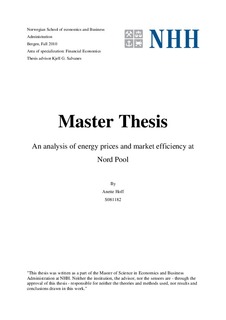| dc.description.abstract | The main objective of this thesis consists of two parts, an analysis of special characteristics of electricity prices at Nord pool and an assessment of how market efficiency1 has changed as the market matured.
The analysis revealed that the electricity prices have idiosyncrasies not found in other commodities. The non-storability of electricity is one of the major causes for this. Nord Pool’s market supply is highly represented by hydro electricity producers. This makes it easy for suppliers to adjust their production to shifting electricity prices. The demand side does not have this freedom, which gives market power to the supply side.
The fundamentals of electricity give the prices a natural pattern within a day, week and year. The prices also exhibit large fluctuations and price spikes due to demand moving different power generating assets in and out of the market. Higher levels of demand bring assets on the upper, steeper portion of the supply curve in to production (i.e. assets with higher marginal production cost). Small changes in demand at this level will result in high price variations. An increase in the general demand without any major addition in production may cause a lasting shift in the demand curve to a steeper part of the supply curve and may be one factor to explain the higher and more volatile prices observed in the electricity market after 2005.
Forward prices have seemingly the same characteristics as the spot prices, represented by the high correlation coefficient of over 95%. However, the relationship between spot and forward prices gives valuable information in assessing how the market prices the forward contracts.
Efficiency in a market is influenced by the number of market participants and the liquidity in the market. Both have increased considerably since the opening of Nord Pool, and one could expect the efficiency to increase as the marked matured. However, the results from this analysis showed that it was only an increase in the 1 week contract. The other contracts in the analysis (2-6 weeks contracts) did not show an increase in efficiency. An extended analysis based on contracts with longer delivery periods (month, quarter, year) would be of interest. It may show better market efficiency improvement, since liquidity has increased for these contacts. | en |
